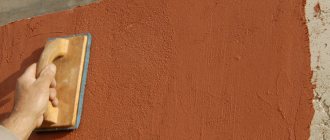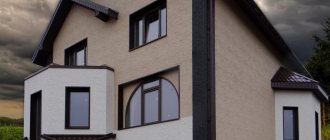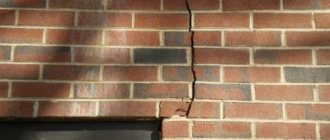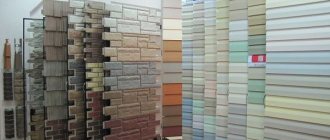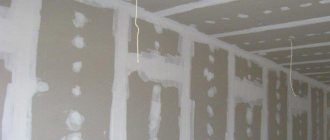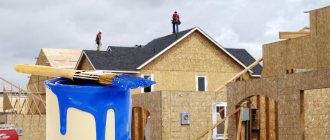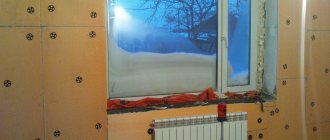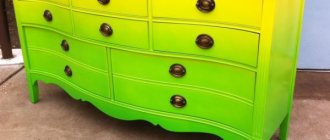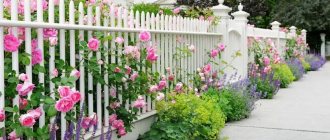Corrugated sheeting, also called corrugated sheets, is one of the simplest and most inexpensive materials for various types of work. That is why this solution is so common among professionals and private craftsmen. A facade made of corrugated sheets can become part of not only a residential building, but also a building for economic and industrial purposes.
You should not assume that when choosing such an architectural solution, the appearance of the building will turn out to be unpresentable and cheap. Using this material you can get a rather interesting design of the facade. To do this, corrugated sheets can be combined with other finishing materials.
Basic properties of the material
Facade corrugated sheeting is popular not only because of its low cost and ease of installation. The good thing about canvases is that they are offered for sale in a wide range of shades, are characterized by durability and allow you to save on installation. The sheets are made of galvanized steel, which is coated with a layer of polymers. The material has an anti-corrosion coating and is also protected with primer and paint. The thickness of the profiled sheet can reach 16 mm. Finishing the facade with corrugated sheets is simplified, because manufacturers offer additional elements, for example:
- corner pads;
- moldings;
- low tides
Execution of house cladding
- preventing the impact of negative external factors on the walls of the building;
- Due to the air gap, timely airing and ventilation of the interprofile space is guaranteed, so that mold does not appear and condensation does not form.
- fastening sheets to a ready-made surface, in this case, a wall;
- covering each prefabricated element of the future wall with sheets.
- Installation of a metal frame on the wall, assembled from mounting brackets. The structure is leveled and checked for level, then fixed with dowels. Wooden slats can be used as frame elements, but a metal frame still has the best performance qualities. To sheathe a house with corrugated sheets, both vertical and horizontal arrangement of sheets is allowed. Some developers are experimenting with diagonal orientation of the material.
- Laying insulation, on top of which a vapor barrier film is attached.
- The frame is ready, and corrugated sheeting can be mounted to it, as shown in the photo. In this case, galvanized steel screws should be used as fasteners, each of which is equipped with a moisture-proof gasket.
- The work is completed with the installation of additional elements.
- The guide profile is fixed to the foundation of the building using anchors.
- Racks with an upper lintel are mounted on top of the profile - this creates a wall frame.
- Each cell of the frame is filled with heat-insulating boards.
- The corrugated board strips are attached to the side of the frame.
- Sheets of corrugated sheets are fixed according to the same principle as conventional wall cladding.
- good sound insulation;
- increased roof thermal insulation;
- reliable protection from atmospheric factors;
- the ability to implement complex design tasks.
Types of profiled sheets for facades
The facade made of corrugated sheets can be equipped using different types of fabrics. The material can be classified according to its profile, or more precisely, according to its:
- width;
- height;
- form;
- mind.
Depending on the height and size of the profile, the material belongs to one brand or another. The larger the number next to the letter in the marking, the higher the profile and load-bearing capacity, because the ribs have more impressive dimensions, and the metal has good thickness and rigidity.
Before covering the facade with corrugated sheets, you should consider whether the foundation, as well as the walls, can withstand additional loads, because the corrugated sheet will have a more impressive mass with increasing thickness.
If you want to carry out wall cladding, limiting yourself to a modest budget, you should choose a thin profiled sheet. This indicator for the material starts from 0.35 and ends at 1.2 mm. Economy and super-economy class materials are canvases of the smallest thickness, the maximum value of which reaches 0.4 mm.
Attention! Experts recommend covering the façade with corrugated sheets, the standard width of which is 0.5 mm. The same canvases can also be used to install a fence.
Pros and cons of finishing the facade with corrugated sheets
In addition to the external walls of the house, you can also trim the base with corrugated sheets. This type of cladding has many advantages. Firstly, it is durable. Secondly, it is easy to care for. Thirdly, external walls resist ultraviolet radiation well and practically do not fade. The installation of corrugated sheets on the facade should also be carried out due to the elasticity of the material. The material itself is quite cheap, and working with it does not involve large expenses. A house sheathed using this technology has a cladding that is resistant to corrosion and temperature.
But the described finish also has its drawbacks. For example, although it can withstand high temperatures, a person who touches such a wall in hot weather can get burned. Corrosion resistance is also relative, because metal is subject to negative influences when cut. Corrugated walls are also quite noisy. This is especially noticeable during slanting rains. But the bonus of such cladding is that moisture does not penetrate under the cladding of the house thanks to the insulation and additional layers - wind, moisture and water protection.
Price
Before you start decorating the walls of your house, you should ask about the cost of the material. The price will depend on the type of profiled sheet for cladding. The color also affects the price. If the thickness of the material is 0.45 mm, then you will have to pay 254 rubles per square meter. We are talking about a colorless sheet with a zinc coating. If the thickness increases to 0.8 mm, you will have to pay 875 rubles for the material. per square meter. The color of the canvas will be white, and polyester will be used as a coating.
For a thickness of 0.9 mm, the consumer will pay 700 rubles. per square meter. The price here is lower than that of a canvas with a less impressive thickness due to the fact that the material is colorless and zinc acts as a coating.
Classification
If you decide to clad your house with corrugated board, then you should know that the thickness of the material can be in the range of 0.4-1 mm
If you decide to clad your house with corrugated sheeting, then you should know that the thickness of the material can be in the range of 0.4-1 mm and depends on the classification of the product:
- The façade of the house must be finished using a profiled wall sheet. These are products of small thickness with low strength and rigidity. The material is not designed for significant loads and is attached to vertical surfaces. This sheet is also used as a finishing coating in suspended structures. Such profiled sheets are marked with the letter “C”.
- The roofing material is thick, strong and rigid. It is used as a roofing covering for the construction of cabins, fences, canopies and canopies. Such a profiled sheet can withstand more loads than profiled wall material. Products are marked with the letters “NS”.
- The strongest and thickest metal profile is a load-bearing profiled sheet. This material can withstand significant loads, but its price is the highest. Such products are used for the manufacture of various load-bearing structures and for the installation of permanent formwork. The material is marked with the letters “N” or “K”.
Attention: to cover a building with corrugated sheets with your own hands, you will need profiled wall material.
Material calculation
In order to calculate the profiled sheet for the facade, you should determine the area of each wall being finished and add up these numbers. Next, the area of one sheet is determined. The first value should be divided by the second, which will allow you to obtain the required amount of material. From this value you can subtract the area of all window and door openings. But the canvases will still have to be purchased with a reserve of approximately 15%. Therefore, the last action may not be performed.
Attention! A ventilated façade made of corrugated sheets will require more cladding due to the fact that the material will be installed on a frame whose area is slightly larger than the area of the walls of the house.
When covering a house with corrugated sheets, some consumers have a desire to save money. They purchase budget-class material. But its appearance is not as satisfactory as that of canvases with a colored coating. If your budget is limited, you can purchase economy-class profiled sheeting and then paint it. The need may arise if the finish has been damaged by hail or other mechanical impacts.
Paint for corrugated sheets may be needed if the material was purchased at a discount and was damaged. Sometimes the canvases are subjected to careless loading/unloading, and upon arrival at the construction site they have chips, scratches and damage. To carry out such work, you can use alkyd enamel. This solution must be designed to be applied to galvanized metal.
Advantages of facade finishing with corrugated sheets
Of course, you can use absolutely any materials that are suitable for this as cladding. However, corrugated sheeting in this case has a number of undeniable advantages.
Characteristics of facing corrugated sheeting
- Corrugated sheeting is an economical building material. You will save not only on the material itself, but also on installation work if you want to use the services of professional builders.
- Durable design. Provided that the corrugated sheeting is installed correctly, it will last long enough and will not require additional maintenance or repairs. The service life of this building material is at least 50 years.
- Profiled sheets are quite resistant to corrosion; they are not particularly affected by negative external factors, such as the scorching sun, precipitation or low temperatures.
- The building material is absolutely fireproof.
- Attractiveness. If corrugated sheeting is installed correctly, and you also choose a building material of an unusual color, it will have not only practical, but also aesthetic functions.
- Easy to install. This is an undoubted advantage that sets corrugated sheets apart from other materials. The work will be completed in the shortest possible time, auxiliary building materials are simple and inexpensive.
Installation of a ventilated facade made of corrugated sheets
Sheathing a house with corrugated sheets is carried out according to a certain algorithm. At the first stage, the wall should be prepared, and then you can begin installing the brackets. The sheathing will be attached to them. Insulation involves attaching thermal insulation using dowel umbrellas.
Horizontal profiles are fixed to the brackets. If necessary, they are additionally strengthened with vertical jumpers. To cover a house with finishing material, corrugated sheeting is installed with an overlap in one wave. Sealing can be ensured using self-tapping screws with press washers and rubber gaskets. Sheathing with corrugated sheets is carried out using a plumb line. If the building is located in a region with strong wind loads, the frame is mounted using a thin-walled pipe.
Preparation of material and tools for installation of corrugated sheets
Before finishing a house with corrugated sheets, you should ensure that you have a certain set of tools and materials. The master will need:
- metal purlins;
- self-tapping screws;
- anchors;
- guides;
- basement ebb;
- paronite gaskets;
- corners;
- slope strips.
The frame can be installed using self-tapping screws. For ease of use, you can prepare a screwdriver. If you do not have a low-speed saw with which you can cut corrugated sheets, you should prepare metal scissors. It is convenient to process the edges of the corrugated sheet with a hacksaw.
Marking attachment points
The locations of the brackets will need to be marked on the walls of the house. The vertical distance between them will be 1000 mm, horizontally – 800 mm. For work, you can use a mounting or reinforced bracket. After the marking has been carried out, holes need to be drilled at the points to install anchors.
Installing brackets on a paronite gasket
The walls of the house should not have cold bridges, so heat loss should be reduced as much as possible. In those places where the brackets will be adjacent to the facade, a paronite gasket is installed under them. Drilling is most conveniently done with an electric drill.
Attention! If the cladding of the house is made using marble chips, for a more tight fixation of the reinforced bracket, you can install it without a paronite gasket. this recommendation is correct if there is no cold bridge at the junction point.
The brackets are installed on a paronite gasket to prevent the transfer of condensation to the façade from the anchor. This will reduce the risk of materials destruction. To refuse this element means to increase the risk of destruction of the entire structure. The bracket is attached to a pair of anchors. You should retreat 300 mm from the edge of the profile.
Installation of insulation
Corrugated sheeting for facades is not only cheap and easy to install, but also provides a thermal insulation layer. Insulation boards are installed starting from the bottom. They are placed as closely as possible to each other; there should be no voids in the seams. If cracks are noticed, they should be sealed with pieces of the same material. To fix the insulation, a dowel-anchor with spacers is used. The length of the dowel should be selected taking into account the thickness of the thermal insulation. There should be about 7 fastenings per square meter. Installation is carried out with preliminary drilling of holes not only in the insulation, but also in the wall.
Attaching the windproof membrane
If windproof film is to be laid, the insulation boards are secured with two dowels. Only after the film has been laid can the rest of the fasteners be installed. The material is installed with an overlap. This method will provide reliability and greater efficiency.
Installation of sheathing under corrugated sheets
To cover a house with corrugated sheets, you need to install a frame. To do this, the profiles are connected to brackets and secured with self-tapping screws. In order to prevent the elements from moving when tightening the fasteners, you should use a clamp. This will free the master’s hands and ensure the evenness of the elements.
Installation of horizontal profiles
This stage is the simplest, because the vertical elements have already been installed, which means that the horizontal elements are fastened according to the existing level. The same fasteners must be used.
Attaching the corrugated sheet to the profile
At the next stage, you can proceed to installing galvanized corrugated sheets. Fastening is carried out with self-tapping screws. The fasteners should not be pressed to the extreme position; this distance will be needed for temperature compensation. Sheets are installed from bottom to top. You need to move to the right. Looking at the photos of facades made of corrugated sheets, you can understand that the appearance of the walls is ideal. This is because professionals usually use leveling technology. The starting row must be mounted along the drainage bar. The vertical position of the sheets is checked by a level.
Additional elements for facade openings made of corrugated sheets
Installation of corrugated sheets for the facade may involve the use of complex and simple additional elements. The first should be attached before fixing the profiled sheet, the second - after. If the consumer decides to cover the walls with corrugated sheets rather than metal siding, most likely, the building materials store will offer him simple additional elements.
They are easily installed on an already mounted surface. But when the work uses material with a low profile (up to 10 mm), it is possible to use complex additional elements. The opening casing, which is also called a slope, is located on openings and walls that have already been lined. Platband - at the top of the door - above the drip.
How to fasten corrugated sheets
Installation of a profiled sheet involves fixing it to the frame.
A galvanized self-tapping screw with a rubber gasket is used to secure the corrugation in increments of 35 cm. Self-tapping screws for corrugated sheets have a thread and a special tip in the form of a drill. They are usually made from high-strength alloy carbon steel grade C1022 with a finishing zinc coating. The design of the self-tapping screw with such a tip allows them to be attached to the frame without pre-drilling holes.
So, self-tapping screws for corrugated sheets with a diameter of 4.8 mm can drill through metal 2.5 mm thick.
Rubberized gaskets protect the cavities of the building material from moisture.
The sheets are always laid with an overlap of 5 cm. When cutting metal, the burr is removed so as not to cut yourself.
Additional elements are fixed along the entire perimeter of the house (corners, doors, windows). Then the building receives a complete and neat appearance.
Attention! Do not use a punch or nails.
Fastening corrugated sheets with self-tapping screws
